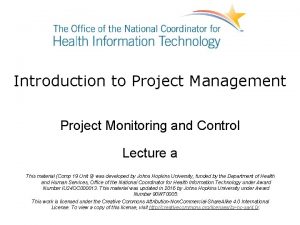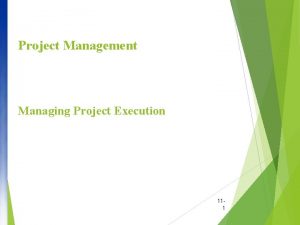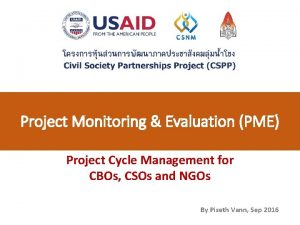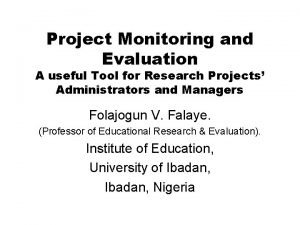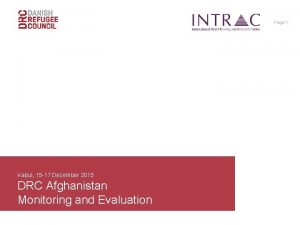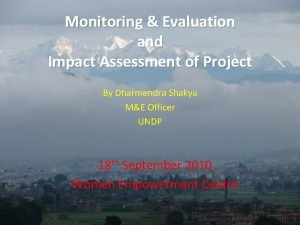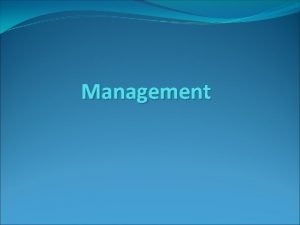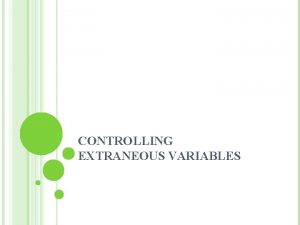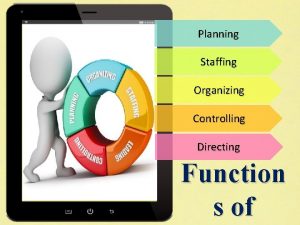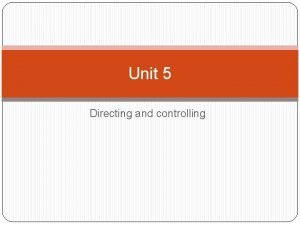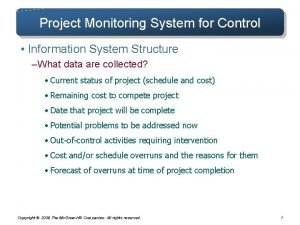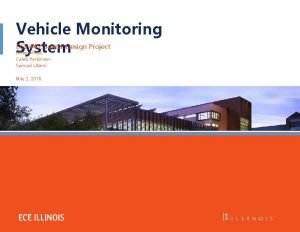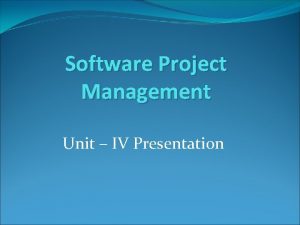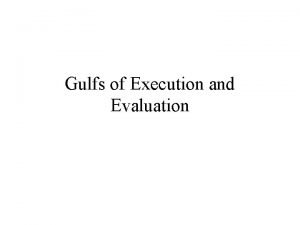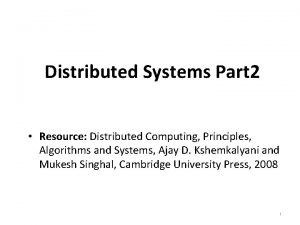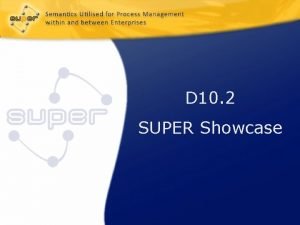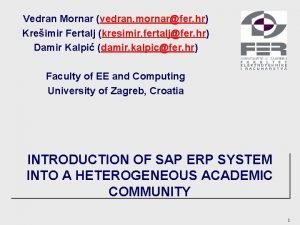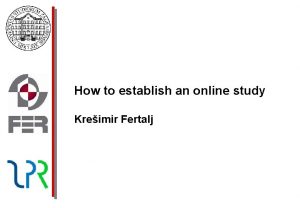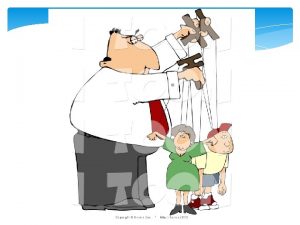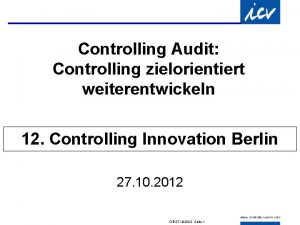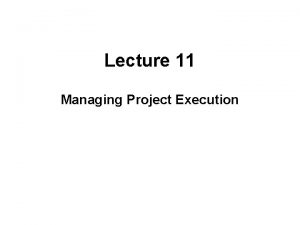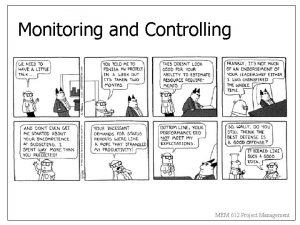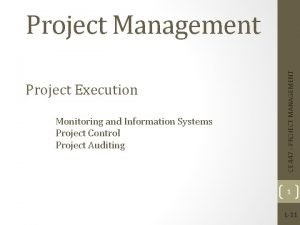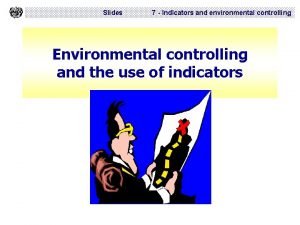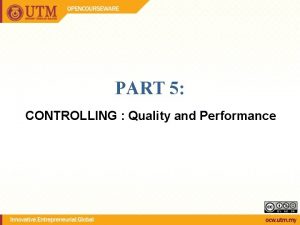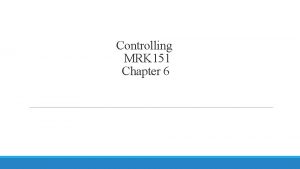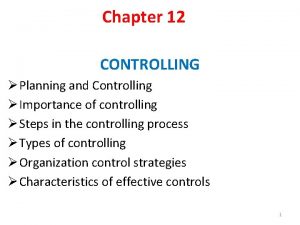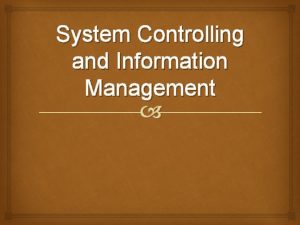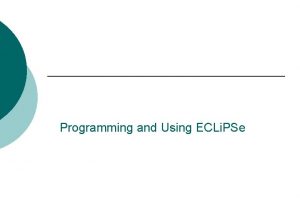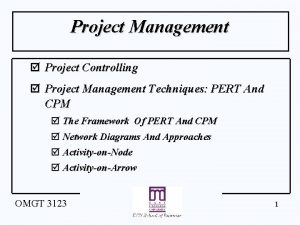Project Execution Monitoring and Controlling Kreimir Fertalj Faculty


























- Slides: 26

Project Execution, Monitoring and Controlling Krešimir Fertalj Faculty of EE and Computing, Zagreb DAAD 2012, Opatija

Introduction q Project management institute (PMI) q Book of Knowledge (PMBOK) q Practical view q Identification of project processes q Management through 4 iterations: plan-do-check-act q Process interactions Planning Closing Initiating Executing Monitoring and controlling DAAD 2012, Fertalj: Project Executing, Monitoring and Control 2

Executing Process Group q Executing Process Group n Coordinating people and resources n Execution of project activities n Integration of activities according to project plan n Scope management and change management DAAD 2012, Fertalj: Project Executing, Monitoring and Control 3

Executing Processes (2) q Beginning Vendor Solicitation n obtaining bids, proposals, quotations n for the services or the goods to be purchased for the project completion q Determing Vendor Source n making a decision as to which identified vendor will be the source of the service or good being procured n based upon the selection criterion determined by the performing organization q Administering Contracts n the contract typically is a document that represents the offer and acceptance of both parties n some organizations may utilize centralized contracting or a contracting office DAAD 2012, Fertalj: Project Executing, Monitoring and Control 4

Executing Processes (3) q Mapping to Quality Assurance n verify that the project work results are mapping to the organization's quality assurance program as described in the quality management plan q Dispersing Project Information n dissemination of information according to the communications plan q Ensuring Team Development n may involve classroom learning, shadowing between project team members, or on-the-job training DAAD 2012, Fertalj: Project Executing, Monitoring and Control 5

Workload management q Performance measurement n Time tracking n Analysis of workload structure Person Date Project Work Hours Description q Improving Efficiency 1. Delegating (to somebody else) 2. Reduction (of tasks that would not be accomplished at all) 3. Prioritizing (A, B, C; 1, 2, 3; high, medium, low; . . . ) 4. Combination of 3 i 1 5. Separation/deviding of task lists 6. Optimization of sequencing of tasks within the same priority DAAD 2012, Fertalj: Project Executing, Monitoring and Control 6

Monitoring and Controlling Process Group q Monitoring and Controlling Process Group n Monitoring – collecting, recording, and reporting information concerning project performance that project manger and others wish to know n Controlling – uses data from monitor activity to bring actual performance to planned performance DAAD 2012, Fertalj: Project Executing, Monitoring and Control 7

Controlling Processes q Verify project work and the response to that work n Ensure the project goes according to plan – by monitoring n Ensure the actions to implement when evidence proves the project is not going according to plan q Ensuring Quality Control (QC) n measures work results against quality standards n If the work results are not of quality - determine why the results are inadequate and how to eliminate the causes q Providing Scope Verification n verifying that the work results are within the scope n typically done at project phase completion, with the customer n If the scope has not been met - the project may be halted, reworked, or delayed DAAD 2012, Fertalj: Project Executing, Monitoring and Control 8

Controlling Processes (2) q Implementing Scope Change Control n change management plan - to ensure unneeded changes to the project scope do not occur n eg. scope creep, by implementing advanced functionality not being planned nor approved q Leading Configuration Management n ensures the description of the project's product is precise, complete, and that it meets the demands of the stakeholder requirements n monitors, guards, and documents changes to the scope n (part of) change control system q Overseeing Change Control n Needed changes must be proven, documented, and analyzed for impacts on cost, schedule, and risks n may involve a Change Control Board that reviews, approves, or rejects the proposed changes DAAD 2012, Fertalj: Project Executing, Monitoring and Control 9

Controlling Processes (3) q Managing Cost Control n requires accurate estimates and then a check and balance against those estimates n procurement management, cash flow, and fundamental accounting practices are required n hinges on hidden and fluctuating expenses such as shipping, exchange rates for international projects, travel, and incidentals q Enforcing Schedule Control n constant monitoring of the project's progress n approval of phase deliverables, and task completion n slippage must be analyzed early in the project to determine the root cause of the problem n may indicate inaccurate estimates, hidden work, or a poor WBS n also consider outside influences and their affect on the project-for example, weather, market conditions, cultural issues, etc. DAAD 2012, Fertalj: Project Executing, Monitoring and Control 10

Controlling Processes (4) q Monitoring Risk Response n requires risk ownership and monitoring n pay special attention to the possible risks and the mitigation plans n risk responses, should they be acted on, may cause secondary risks, cost increases, and schedule delays ! q Ensuring Performance Reporting n report and record accurate completions of work n Earned Value Management (EVM) n schedule baselines n cost baselines n milestones DAAD 2012, Fertalj: Project Executing, Monitoring and Control 11

Balancing the Control System q Regular intervals q More control – lower risk – higher costs q Basic principles n Monitor work, not employees n To increase efficiency n To verify completness (by inspecting the results) q Key questions n What is the actual project status ? n Which are the reasons for deviations from plan ? n Is there a need for corrections, by which measures ? DAAD 2012, Fertalj: Project Executing, Monitoring and Control 12

Progress Reporting System q Data collection n daily, weekly, monthly n dynamic adjustment depending on execution n good information infrastructure required q Tracking techniques n Status review • Review meetings (project team, PM board, steering commitee) • Status reports n Forms • Eg. planned start, real start, current date and status, planned finish … • Description of work n Gantt tracking • Percent complete DAAD 2012, Fertalj: Project Executing, Monitoring and Control 13

Some problems q “ 90% completed“ syndrome q Emphasis on good/bad information n “good news” syndrome – upward information filtering q Consequences n Bad estimates n Wrong decisions n “Garbage in - garbage out” DAAD 2012, Fertalj: Project Executing, Monitoring and Control 14

Controlling techniques q Ignoring q Corrective actions n npr. urging, or forcing of “good will” q Revision of plan n Resource leveling n Rescheduling q Increased monitoring n Adjustment of frequency of data gathering and reporting n Level of tracking details q Cost control 15

Examples q Business projects, student projects, seminars, degree theses, … 16


Cost control

Earned Value Management q Earned value management (EVM) n is a project performance measurement technique • that integrates scope, time, and cost data. q Given a baseline, one can determine n how well the project is meeting scope, time, and cost goals • by entering actual information • and then comparing it to the baseline. q The baseline information includes: n Scope data (WBS tasks) n Time data (start and finish estimates for each task) n Cost data (cost estimates for each task) DAAD 2012, Fertalj: Project Executing, Monitoring and Control 19

Earned Value Analysis q PV (Planned Value) n Value of work planned for a given period (“up to now”) q EV (Earned Value) n Value of work actually q AC (Actual Cost) n Real costs q BAC (Budget at Completion) n Planned project value, approved total budget q EAC (Estimate at Completion) n a forecast of how much the project will cost upon completion n AC + ETC (Estimate to Complete) DAAD 2012, Fertalj: Project Executing, Monitoring and Control 20

Earned Value Analysis – basic idea © Wysocki: Effective Project Management, Wiley, 2003. DAAD 2012, Fertalj: Project Executing, Monitoring and Control 21

Earned Value Analysis (1) q (Cost Variance) CV = EV – AC n CV<0 – over budget, CV>0 – within budget q (Schedule Variance) SV = EV – PV n SV<0 – behind schedule, SV>0 – before schedule © Wysocki: Effective Project Management, Wiley, 2003. DAAD 2012, Fertalj: Project Executing, Monitoring and Control 22

Earned Value Analysis (2) q "S" curve q Performance Indices q CPI (Cost Performance Index) n CPI = EV / AC n CPI < 1 – over budget q SPI (Schedule Performance Index) n SPI = EV / PV n SPI < 1 – behind schedule DAAD 2012, Fertalj: Project Executing, Monitoring and Control © Wysocki: Effective Project Management, Wiley, 2003. 23

Example q q q Building a fence For each side : 1 day, 1000 $ Finish-Finish activity dependancy Status at the end of day 3 ? S --- Actual Start, F — Actual Finish, PS --- Planned Start, PF --- Planned Finish Status on Day 3 Activity Side 1 Side 2 Day 1 2 3 4 Completed, 1000 spent S----F S----PF Side 3 Side 4 DAAD 2012, Fertalj: Project Executing, Monitoring and Control -------F Completed, 1200 spent PS—S--PF 50% completed, 600 spent PS------PF Not started 24

Results q Planned value n PV = 1000 + 1000 = 3000 q Earned value n EV = 1000 + 500 = 2500 q Actual costs n AC = 1000 + 1200 + 600 = 2800 q Budget n BAC = 1000 + 1000 = 4000 q Cost variance n CV= EV – AC = - 300 (over budget) q Schedule variance n SV = EV – PV = 2500 – 3000 = - 500 (behind schedule) q Estimate at complete n CPI = EV / AC = 0. 89 n EAC = BAC / CPI = BAC / (EV/AC) = 4479 DAAD 2012, Fertalj: Project Executing, Monitoring and Control 25

References q A Guide to the Project Management Body of Knowledge, 4 th Edition, PMI, 2010 q Rita Mulcahy, PMP Exam Prep, 7 th Edition, RMC Publications, Inc. , 2011 q Fleming, Quentin W. and Joel M. Koppelman, Earned Value Project Management, 4 th Edition, PMI, Newtown Square, PA 2010 q T. T. Wilkens: Earned Value, Clear and Simple n http: //handle. dtic. mil/100. 2/ADA 402619 q Earned Value web page n www. acq. osd. mil/pm DAAD 2012, Fertalj: Project Executing, Monitoring and Control 26
 Project management monitoring and controlling
Project management monitoring and controlling Direct and manage project execution
Direct and manage project execution Chapter 4 project integration management
Chapter 4 project integration management University management system project report
University management system project report Pme project management
Pme project management Tools for project monitoring and evaluation
Tools for project monitoring and evaluation Example of monitoring and evaluation in project proposal
Example of monitoring and evaluation in project proposal What is monitoring
What is monitoring Planning organizing staffing leading and controlling
Planning organizing staffing leading and controlling Planning directing controlling
Planning directing controlling Suporting idea
Suporting idea Who are managers?
Who are managers? Constancy of condition
Constancy of condition Topic controlling idea
Topic controlling idea Staffing and controlling
Staffing and controlling Staffing and directing
Staffing and directing Planning organizing leading and controlling
Planning organizing leading and controlling Example of topic sentence and supporting details
Example of topic sentence and supporting details Directing and controlling
Directing and controlling Starbucks planning organizing leading and controlling
Starbucks planning organizing leading and controlling Structure of a project monitoring information system
Structure of a project monitoring information system Project monitoring meaning
Project monitoring meaning Vehicle monitoring system project
Vehicle monitoring system project Ball chart in spm
Ball chart in spm Gulf of evaluation
Gulf of evaluation Mutual exclusion in distributed system tutorialspoint
Mutual exclusion in distributed system tutorialspoint Process and execution
Process and execution
